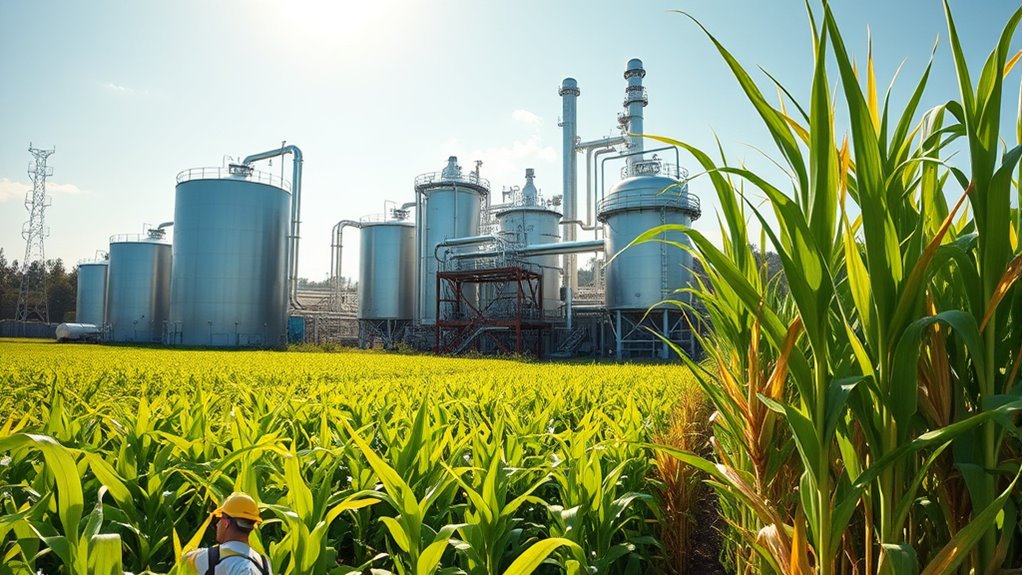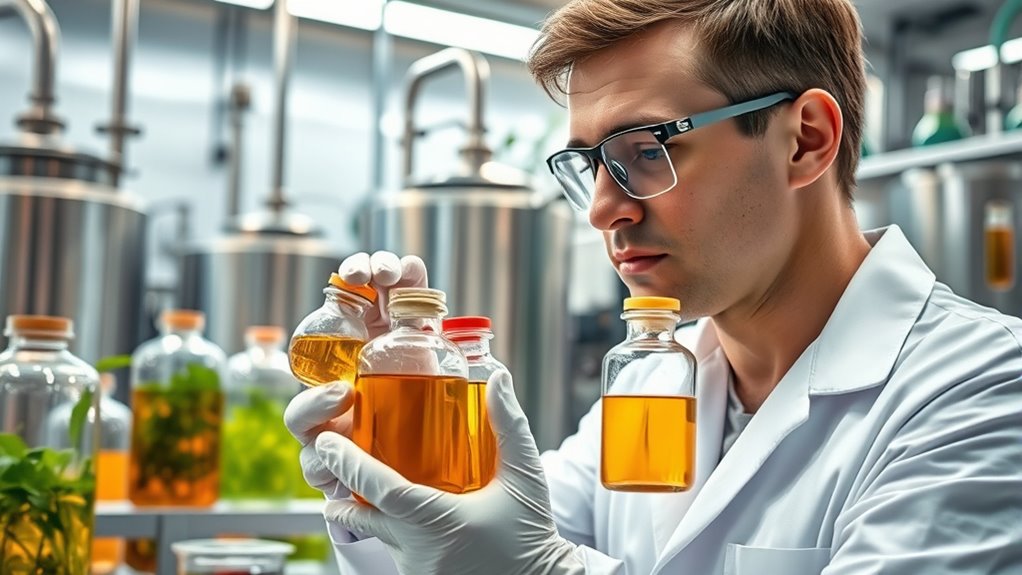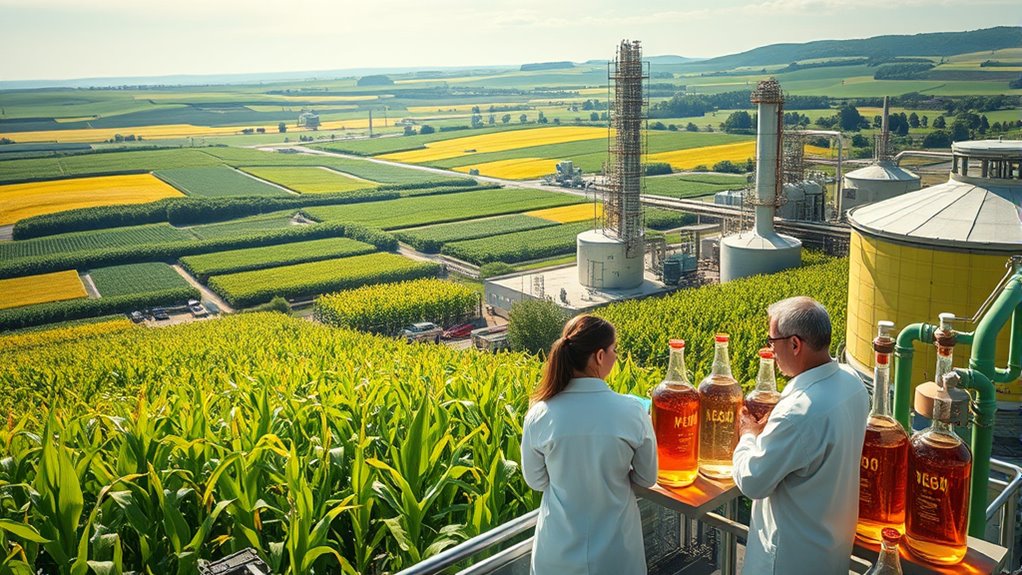Bio-based chemicals are transforming the industry by replacing oil-derived products with sustainable options from renewable resources like plants, waste, and microorganisms. They offer significant environmental benefits, including reducing greenhouse gases and pollution, while supporting a circular economy. Key sectors such as plastics, cosmetics, and construction are embracing these alternatives. Advances in biorefinery technologies and supportive policies are making bio-based chemicals more scalable and cost-effective. Explore further to discover how these innovations shape a greener future.
Key Takeaways
- Bio-based chemicals are derived from renewable resources like biomass, algae, and waste, reducing dependence on fossil oil.
- They offer sustainable alternatives with lower greenhouse gas emissions and environmental impacts compared to traditional oil-based chemicals.
- Advances in biorefinery processes, enzyme engineering, and catalysis enable efficient conversion of biomass into chemical products.
- The market for bio-based chemicals is growing rapidly, driven by demand for greener, biodegradable, and eco-friendly materials.
- Policy support, technological innovations, and industry adoption are key to replacing oil-based chemicals with bio-based alternatives.
The Role of Renewable Resources in Bio‑Based Chemical Production

Renewable resources play a crucial role in transforming chemical manufacturing by providing sustainable alternatives to fossil fuels. You can leverage sources like corn, sugar cane, cellulosic biomass, vegetable oils, insect exoskeletons, and fungal cell walls, all of which can be converted into valuable chemical feedstocks. Nature-based feedstock potential Biomass-derived materials such as bio-naphtha, pyrolysis oil, biogas, and vegetable oils serve as key inputs, often sourced from agricultural residues or waste streams, adding value to low-value materials. Emerging options like algae and fast-growing plants offer high yields without competing with food crops. Microorganisms—bacteria, yeast, fungi—ferment sugars from biomass into chemical precursors, broadening the range of renewable feedstocks. These diverse sources are essential for sustainable chemical production, reducing reliance on finite fossil resources.
Environmental Benefits of Transitioning to Biobased Chemicals

Switching to biobased chemicals offers significant environmental advantages by substantially reducing greenhouse gas emissions. Studies show that emerging bio-based products emit about 45% fewer GHGs over their lifecycle compared to fossil-based ones.
Out of 98 bio-based products analyzed, 80 had lower carbon footprints, and adopting just 15 high-potential chemicals could save over 5.2 million tonnes of CO₂ annually. This reduction surpasses some national fuel policies, delivering notable climate benefits.
Additionally, bio-based chemicals come from renewable resources like plants and waste, decreasing reliance on finite fossil fuels and supporting a circular economy. They also tend to produce less air and water pollution, generate fewer toxic emissions, and are often more biodegradable, reducing long-term environmental impacts. Market growth projections further highlight the increasing adoption and environmental advantages of biobased chemicals worldwide.
Key Industry Sectors Embracing Biobased Alternatives

Several key industry sectors are actively adopting biobased alternatives to enhance sustainability and reduce environmental impacts.
In the advanced materials industry, bio-based chemicals replace petrochemicals in polymers, coatings, adhesives, and fibers, supporting greener supply chains and circular economy goals through biodegradability and recyclability. Bio-based chemicals are increasingly integrated into high-performance materials to meet stringent environmental standards.
The industrial feedstock sector relies on bio-based chemicals for acrylic acid, synthetic rubbers, and coatings, enabling a shift from fossil-based inputs to renewable resources.
In personal care and consumer goods, bio-based ingredients meet consumer demand for natural, eco-friendly products, offering benefits like skin compatibility and biodegradability.
The cosmetics, lubricants, and paints industries use bio-based resins, dispersants, and lubricants to improve environmental profiles and reduce toxicity.
Lastly, construction and packaging sectors incorporate bio-based materials for sustainable composites, biodegradable packaging, and improved resource efficiency, lowering carbon footprints.
Economic Opportunities and Challenges for Bio‑Based Chemicals

The economic opportunities for bio-based chemicals are substantial, driven by growing demand for sustainable products and innovation in the industry. You can access a market projected to exceed $7 trillion by 2030, with bio-based products potentially generating around US$10 billion globally.
Europe leads adoption thanks to strong policies and eco-conscious consumers, while North America and Asia Pacific also show rapid growth.
Europe drives bio-based chemical adoption through policies and eco-conscious consumers, with North America and Asia Pacific rapidly expanding.
Co-production strategies in biorefineries enhance economic viability by maximizing resource use. However, challenges like high startup costs, biomass variability, and price volatility due to low oil prices can hinder competitiveness.
Securing investments requires infrastructure development, supportive policies, and supply chain efficiency. Market acceptance hinges on consumer awareness and regulatory support, which can open new premium segments and long-term economic benefits.
Gold IRA Rollovers can serve as a source of funding for investments in bio-based chemical ventures, providing additional financial flexibility and stability.
Advances in Research and Development for Sustainable Chemistry

Recent advances in research and development are driving the shift toward more sustainable chemistry in the bio-based chemicals industry. You’ll find progress in feedstock diversification, such as converting agricultural residues like corn stover and wheat straw into platform chemicals through improved enzymatic and microbial processes. Additionally, optimizing color accuracy in production processes can help improve product consistency and quality. Researchers are also exploring genetically modified algae strains to boost lipid and carbohydrate yields for bio-plastics and fuels. Waste-to-chemicals pathways are expanding, using catalytic methods to transform municipal waste and CO₂ into ethylene and methanol. Process efficiencies improve with green catalysts, solvent-free technologies, and energy-saving separation methods like membranes. Biocatalytic enzyme engineering and continuous flow reactors enable cleaner, faster synthesis. These innovations are reducing environmental impacts, supporting a more sustainable, circular bio-based chemical industry.
Cutting-Edge Technologies Driving Biobased Chemical Manufacturing

Advances in research have paved the way for innovative technologies that are transforming biobased chemical manufacturing. You now have access to biorefineries, which process biomass into chemicals, fuels, and materials efficiently, reducing waste.
The biomass balance method allows renewable feedstocks to replace fossil resources without sacrificing product quality. Fermentation processes convert biomass into chemicals like amino acids and citric acid, while enzymatic conversions use enzymes to make the process cleaner and safer.
Recycling and upcycling technologies turn organic waste into valuable chemicals, supporting a circular economy. Cutting-edge production techniques, such as advanced biomass separation and catalytic chemistry, improve yields and purity.
These innovations enable integration with traditional industries, making biobased chemicals more sustainable, cost-effective, and scalable for real-world applications. Site speed optimization further enhances the efficiency of biobased chemical manufacturing by ensuring quick processing and delivery times.
Regulatory Frameworks Supporting Sustainable Chemical Innovation

Regulatory frameworks play a crucial role in shaping the development and adoption of sustainable chemical innovations, especially as industries shift toward bio-based solutions. The European Commission’s Chemicals Strategy for Sustainability (CSS) promotes faster adoption of safer, more sustainable chemicals through initiatives like Safe and Sustainable-by-Design (SSbD). This voluntary framework guides research, policy, and funding to develop eco-friendly products.
Overcoming regulatory barriers requires collaboration among industry, academia, and policymakers, along with incentives that foster innovation without sacrificing economic viability. Incorporating new approach methodologies (NAMs), such as in vitro and in silico tools, helps assess safety early in development.
International cooperation and harmonized standards are essential to guarantee consistent, effective regulations that support the global transition to bio-based chemicals. Cookies and user consent management also play a vital role in ensuring transparency and compliance with privacy regulations during the development and deployment of innovative chemicals and related digital tools.
Market Trends and Future Outlook for Bio‑Based Chemicals

The market for bio-based chemicals is experiencing rapid growth driven by increasing demand for sustainable, eco-friendly alternatives to traditional petrochemicals. Valued at around USD 96.39 billion in 2023, it’s projected to reach over USD 197.56 billion by 2032, with a CAGR of approximately 8.3%. Some estimates even suggest the market could surpass USD 296.76 billion, reflecting strong growth potential. This expansion is fueled by rising environmental concerns, depleting fossil fuel resources, and technological advancements in biotech and chemical engineering. Industry adoption of bio-based chemicals is also influenced by market trends, which highlight shifting consumer preferences and regulatory environments. Industries across agriculture, pharmaceuticals, packaging, and textiles are adopting bio-based chemicals to meet sustainability goals and regulatory pressures. As awareness around climate change grows, demand for bio-based solutions will continue to accelerate, shaping a promising future for the industry.
Strategies for Scaling Production and Achieving Cost Competitiveness

Scaling production of bio-based chemicals requires strategic investments in technology, infrastructure, and process optimization. Advancing biochemical process technologies is essential for efficient scale-up, while pilot-scale operations help gather data for commercial plants.
Developing biorefineries that integrate multiple bio-products can cut costs and boost efficiency. Managing feedstock variability through improved processing tech guarantees consistent supply.
Decentralized pyrolysis biorefineries allow closer proximity to feedstocks, reducing transportation costs. To lower costs, focus on processing innovations and increasing production scale to leverage economies of scale.
Improving feedstock efficiency and utilizing existing infrastructure accelerate growth. Building dedicated manufacturing plants and forming partnerships further expand capacity.
Implementing quality control measures and adhering to standards ensure product consistency and market acceptance, helping you achieve cost competitiveness in bio-based chemical production. Renewable energy technologies can also support the energy needs of these facilities, further reducing operational costs and environmental impact.
The Impact of Bio‑Based Chemicals on Global Sustainability Goals

Advancing bio-based chemical production aligns directly with global sustainability goals by reducing environmental impacts and fostering responsible resource use. These chemicals emit 45% less greenhouse gases during their life cycle compared to fossil-based options, helping meet climate targets (SDG 13). Derived from renewable sources like plants, algae, and waste, they support responsible consumption (SDG 12) and promote a circular economy by reducing dependence on finite resources. Their adoption can save over 5.2 million tonnes of CO₂ equivalent annually. Additionally, sustainable land management is crucial to ensure that bio-based chemical production does not lead to deforestation or biodiversity loss. However, challenges like eutrophication risks, regulatory barriers, and scalability issues remain. Still, bio-based chemicals contribute to innovation, sustainable land management, and global policies like the European Green Deal, positioning them as essential tools in achieving multiple sustainability objectives worldwide.
Frequently Asked Questions
How Do Biobased Chemicals Compare in Performance to Traditional Petrochemicals?
You might wonder how biobased chemicals compare to petrochemicals in performance. They often differ structurally, offering unique properties like better biodegradability, enhanced resistance, and specialized functions tailored for specific applications.
While some biobased options match petrochemical performance, others can surpass them, especially in sustainability and safety. Overall, biobased chemicals provide innovative benefits, though cost and adoption pace can influence their practical competitiveness today.
What Are the Main Barriers to Large-Scale Adoption of Biobased Chemicals?
Think of the barriers to adopting biobased chemicals as hurdles in a race you’re trying to win. You face higher costs, inconsistent feedstocks, and lack of infrastructure, making the path bumpy.
Technical challenges slow progress, and regulatory gaps act like unseen obstacles. Consumer confusion and higher prices also weigh down acceptance.
Overcoming these requires better policies, innovation, and education to clear the way for large-scale adoption.
How Do Biobased Chemicals Influence Global Supply Chain Resilience?
You see, biobased chemicals boost global supply chain resilience by reducing dependence on finite fossil fuels and incorporating diverse, regional feedstocks. They simplify logistics through domestic production and waste stream integration, lowering disruption risks.
What Incentives Exist for Companies to Switch to Biobased Chemical Production?
Did you know that Iowa offers a Renewable Chemical Production Tax Credit of $0.05 per pound? This incentive encourages you to produce biomass-derived chemicals locally.
There are caps of $1 million annually for startups. Federal legislation may add a 15% sales-based tax credit, and Minnesota offers $0.075 per pound plus bonuses.
These incentives help you reduce costs, lower your carbon footprint, and comply with evolving regulations, making biobased production more attractive.
How Can Consumers Identify and Choose Biobased Products Effectively?
To identify and choose biobased products, you should look for the USDA Certified Biobased Product label on packaging.
Verify claims by checking third-party lab reports or manufacturer disclosures.
Prioritize products with high biobased content, ideally above 90%.
Use the Biopreferred.gov database to find certified options, and cross-check regional standards like EN ISO 21644.
Reporting misleading labels helps maintain transparency and supports sustainable choices.
Conclusion
As you explore the future of bio-based chemicals, one thing’s clear: the shift from oil isn’t just a trend—it’s a revolution in sustainable production. With ongoing research, evolving regulations, and rising market demand, the next chapter holds surprises that could reshape industries worldwide. Are you ready to witness this transformative journey and be part of a greener, more sustainable tomorrow? The next move could change everything—don’t miss it.









